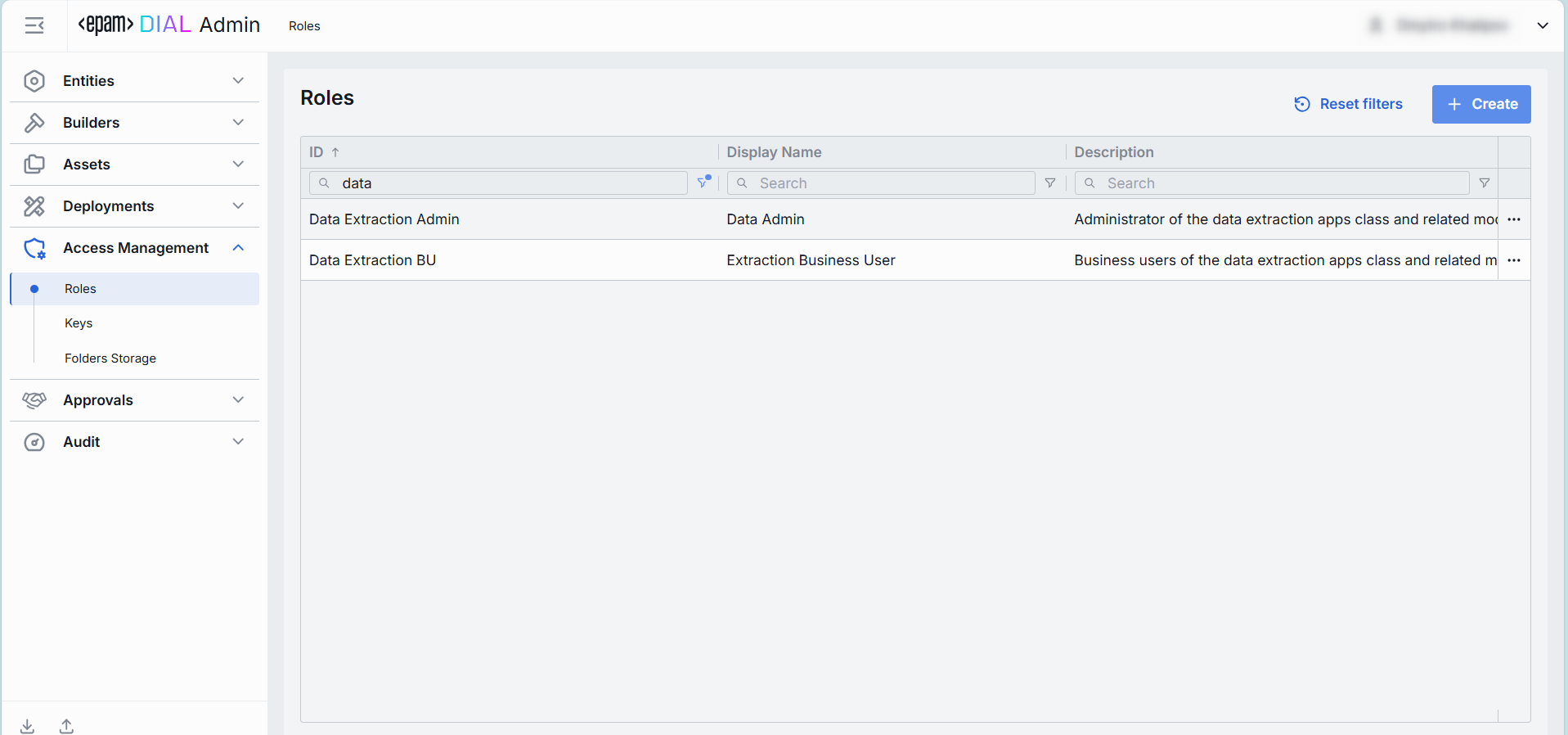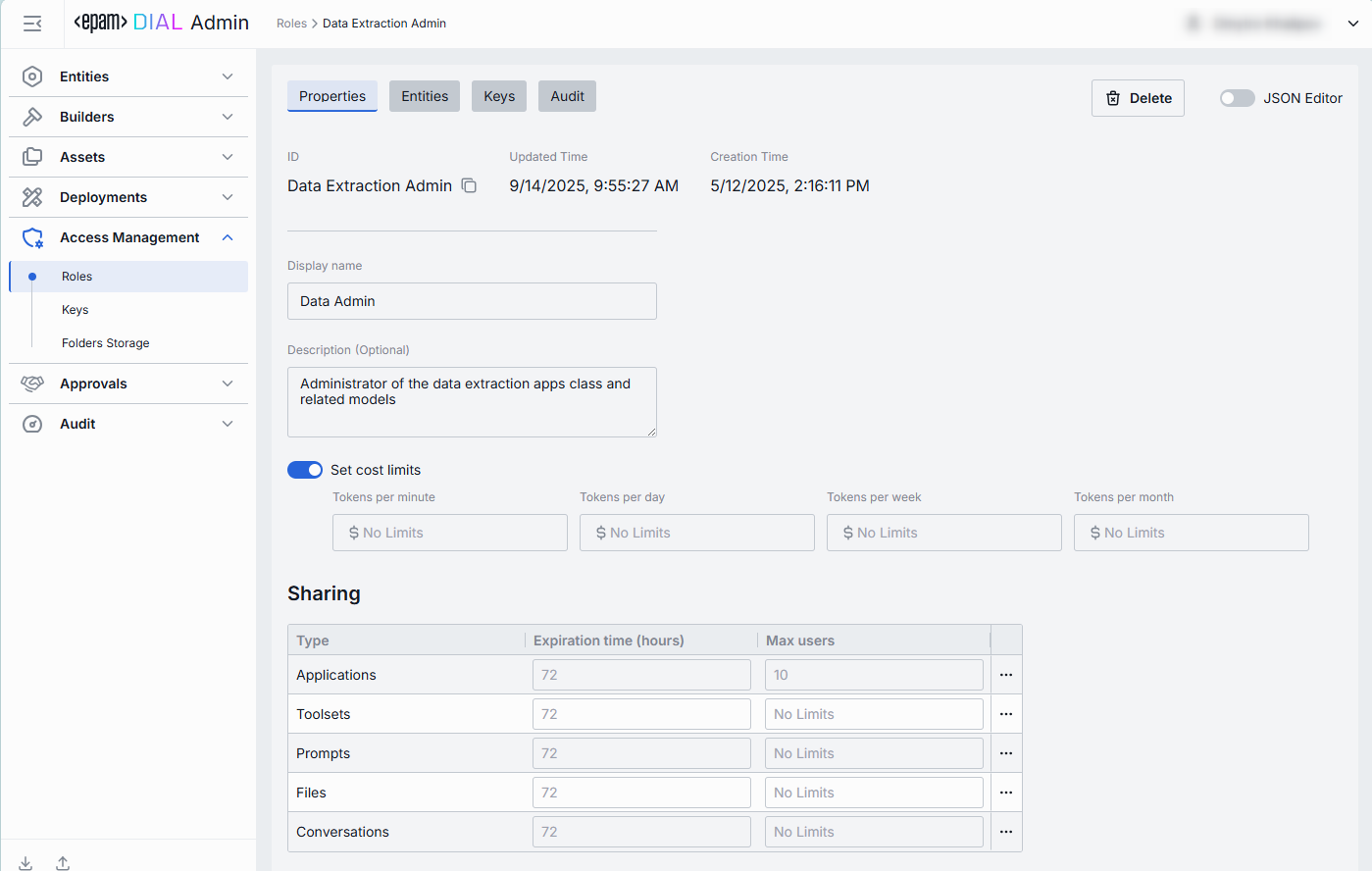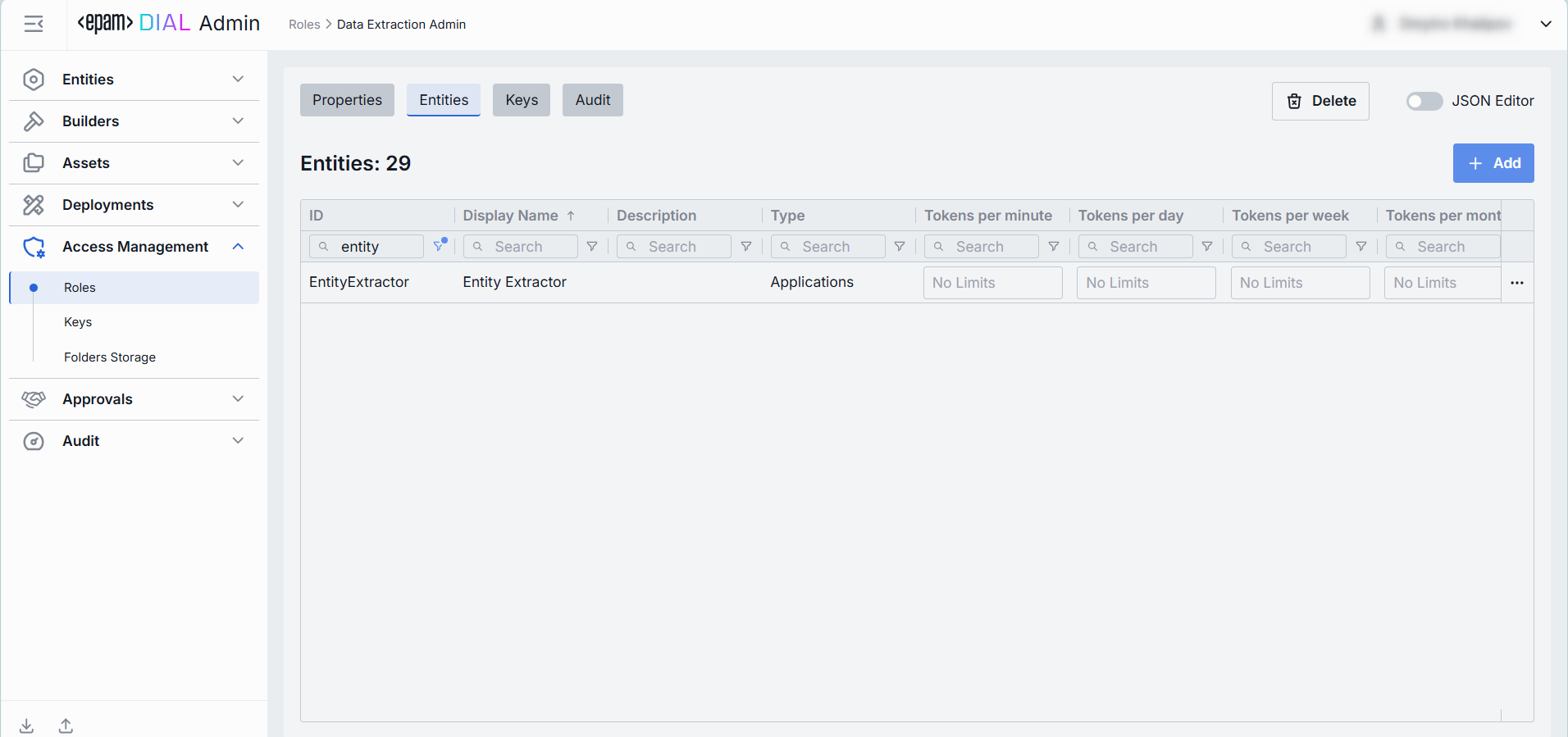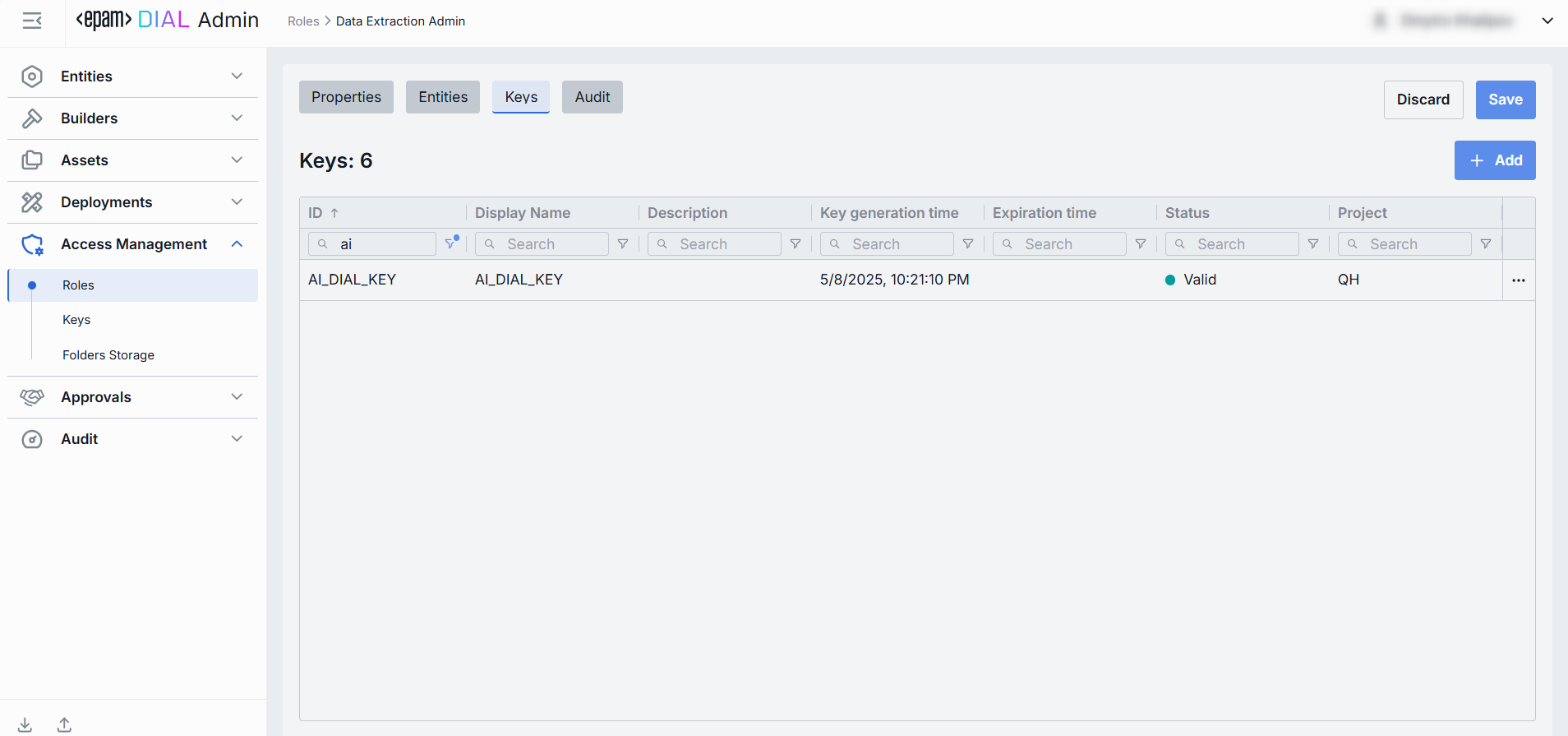Roles
About Roles
Roles are used to enable roles-based access to resources in DIAL.
- Refer to Access Control to learn more about access control in DIAL.
- Refer to Roles to lean more about roles in DIAL.
- Refer to Tutorials to learn how to configure roles for API keys.
- Refer to Tutorials to learn how to configure roles for JWT.
- Refer to IDP Configurations to learn about the supported identity service providers and how to configure them.
Roles Main Screen
In Roles, you can define and manage roles in DIAL.
Roles can also be defined directly in DIAL Core configuration.

Roles Grid
| Column | Definition & Use Case |
|---|---|
| ID | This is a unique key under the Roles section of DIAL Admin. |
| Display Name | A user-friendly name of a role (e.g. Data Extraction Admin, Analysts, Business User). |
| Description | A free-form description of a role (e.g. "Business User role for the Data Extraction application"). |
Create Role
Follow these steps to create a new role:
-
Click Create to invoke the Create Role modal.
-
Define role's parameters:
Column Required Definition & Use Case ID Yes This is a unique key under the Roles section of DIAL Admin. Display Name Yes A user-friendly name of a role (e.g. Data Extraction Admin, Analysts, Business User). Description No A free-form description of a role (e.g. "Business User role for the Data Extraction application"). -
Once all required fields are filled, click Create. The dialog closes and the new role configuration screen is opened. A new role entry will appear immediately in the listing once created.

Role Configuration
Click any role to display the configuration screen.
Properties
In the Properties tab, you can define the identity and metadata for the role. These settings determine how the role appears throughout DIAL and help administrators understand its purpose.

| Field | Required | Description |
|---|---|---|
| ID | - | This is a unique key under the Roles section of DIAL Admin. |
| Updated Time | - | Date and time when the role's configuration was last updated. |
| Creation Time | - | Date and time when the role's configuration was created. |
| Display Name | Yes | A unique identifier of the role, used in ACL selectors and in API calls. |
| Description | No | Optional free-form text describing the role’s intended audience or use. |
| Set cost limits | No | Use to enable token usage limitations. Available values: Tokens per minute, Tokens per day, Tokens per week, Tokens per month. In case limitations for a specific role are not set, the limitations configured for the default role apply. In case limitations for the default role are not set, the value is unlimited. Refer to DIAL Core documentation to learn more about available usage and cost limitations for roles. |
| Sharing | No | Use to set the sharing limits that apply for specific types of resources in DIAL. Expiration time refers to TTL of the invitation link. Default: 72 (hrs). Max users refers to the maximum number of users who can accept an invitation link for a resource being shared. The limit is applied to the shared resource. Default: 10 for APPLICATION and UNLIMITED for other resource types. Refer to DIAL Core documentation to learn more about sharing limitations. |
Entities
In the Entities tab, you can assign which Models, Applications, Toolsets or Routes this role can access, and within which rate limits.

| Column | Definition |
|---|---|
| ID | This is a unique key under of the Entity (e.g., Model, Application). |
| Display Name | A user-friendly name of the resource (Model, Application, or Route) as shown in DIAL. |
| Description | A brief description of the resource. |
| Type | Resource category: one of Models, Applications, Toolsets or Routes. |
| Tokens per minute | Maximum number of tokens this role may consume per minute when calling this resource. |
| Tokens per day | Maximum number of tokens this role may consume per day when calling this resource. |
| Tokens per week | Maximum number of tokens this role may consume per week when calling this resource. |
| Tokens per month | Maximum number of tokens this role may consume per month when calling this resource. |
Add
Follow these steps to assign one or more entities to the selected role:
- Click + Add (top-right of the Entities Grid).
- Select one or more applications/models in the modal window.
- Confirm to insert them into the table.
Remove
Follow these steps to revoke an assigned entity from the selected role:
- Click the actions menu in the entity's line.
- Choose Remove in the menu.
Keys
In the Keys tab, you can assign API keys for roles. API keys are defined in the Access Management → Keys section.

| Column | Definition |
|---|---|
| ID | A unique key under the Keys section of DIAL Admin. |
| Display Name | A user-friendly name of the Key. |
| Description | Additional key’s details, e.g., purpose or usage context. |
| Key generation time | A key's creation timestamp. |
| Expiration time | A key's expiration timestamp. Blank means no expiration (i.e. permanent until manually revoked). |
| Status | The current state of the key. |
| Project | Project associated with the key for the costs tracking purpose. |
Add
Follow these steps to assign one or more API keys to the selected role:
- Click + Add (top-right of the Keys Grid).
- Select one or more keys in the modal. Available API keys are defined in the Access Management → Keys section.
- Confirm to insert them into the table.
Remove
Follow these steps to revoke an assigned API key from the selected role:
- Click the actions menu in the key's line.
- Choose Remove in the menu.
To delete API key, go to Access Management → Keys section.
Audit
In the Audit tab, you can monitor activities related to the selected role.
Activities
The Activities section provides detailed visibility into all changes made to the selected role. This section mimics the functionality available in the global Audit → Activities menu, but is scoped specifically to the selected role.

Activities List Table
| Field | Definition |
|---|---|
| Activity type | The type of action performed on the role (e.g., Create, Update, Delete). |
| Time | Timestamp indicating when the activity occurred. |
| Initiated | Email address of the user who performed the activity. |
| Activity ID | A unique identifier for the logged activity, used for tracking and auditing. |
| Actions | Available actions: - View details: Click to open a new screen with activity details. Refer to Activity Details to learn more. - Resource rollback: Use Resource Rollback to restore the previous version of the related resource. A rollback leads to generation of a new entry on the audit activity screen. |
Activity Details
The Activity Details view provides a detailed snapshot of a specific change made to a role.

To open Activity Details, click on the three-dot menu (⋮) at the end of a row in the Activities grid and select “View Details”.
| Element/Section | Description |
|---|---|
| Activity type | Type of the change performed (e.g., Update, Create, Delete). |
| Time | Timestamp of the change. |
| Initiated | Identifier of the user who made the change. |
| Activity ID | Unique identifier for the specific activity tracking. |
| Comparison | A dropdown to switch between comparison modes: - Before/After - Before/Current state. |
| View | A dropdown to switch between view modes: - All parameters: select to view all parameters. - Changes only: select to view just the parameters that have been changed. |
| Parameters Diff | Side-by-side comparison of role fields values before and after the change. Color-coding is used to indicate the operation type (Update, Create, Delete). |
JSON Editor
For advanced scenarios of bulk updates, copy/paste between environments, or tweaking settings not exposed in the form UI—you can switch to the JSON Editor in any role's configuration page.

Switching to the JSON Editor
- Navigate to Access Management → Roles, then select the role you want to edit.
- Click the JSON Editor toggle (top-right). The UI reveals the raw JSON.
TIP: You can switch between UI and JSON only if there are no unsaved changes.
Delete
Click Delete on the main screen to permanently remove the selected role.